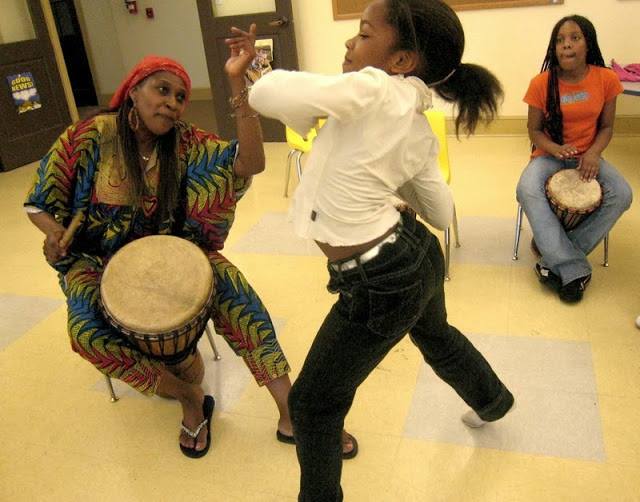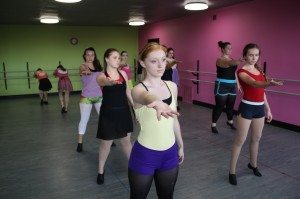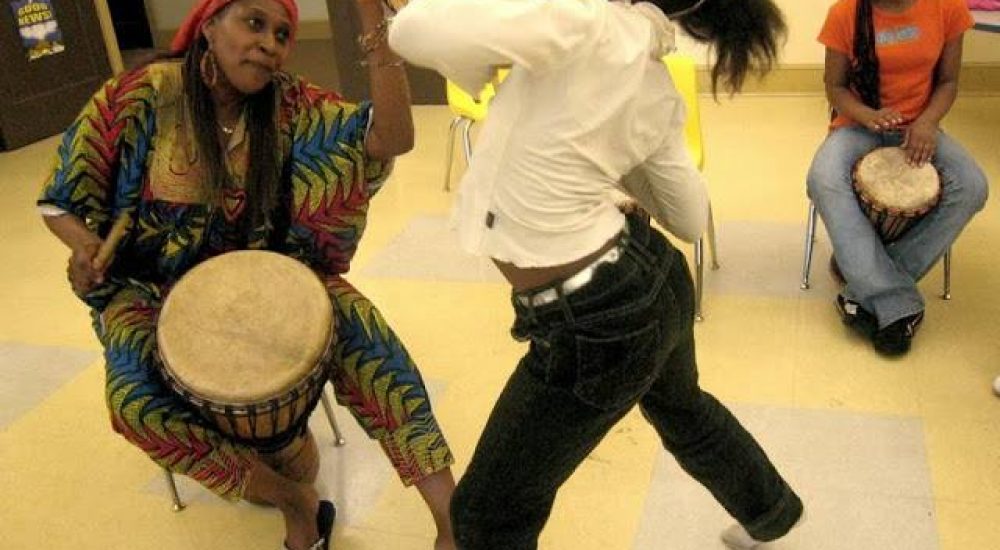Included in this post is a basic outline for a four-session Dance/Visual Arts and Poetry workshop.
The following session series is created around the poem, “Phenomenal Woman” by Maya Angelou. I have used the following experiences as a part of a curriculum for teenage girls who identified challenges with positive self-image and bullying within their peer group.
As you read through the outline keep in mind the age of the children or young people you work with. Also, think about the theme or message you feel needs to be heard and experienced by your young people. The following outline can serve as a starting point for you. Choose your own theme, a poem that fits, and then adapt the experiences appropriately!

Day 1:
1. Opening ritual.
A. Close your eyes and think of one word that describes how you feel right now. Open your eyes when you have it. Close your eyes again and think of one simple movement that represents how you feel. Show your movement and have the rest of the group repeat your movement in unison. Move around the circle until each young person has shared their created movement. You can keep this as a simple call and response or cumulatively add the movements together to create a dance/movement phrase that communicates the collective story of how the group feels today.
2. Facilitator reads “Phenomenal Woman” out loud to the group.
A. Instruct participants to make themselves comfortable, lying down, sitting, or standing.
B. Ask, “What do you think Maya Angelou, the author, means by ‘inner mystery’?”
C. Take several responses. Maintain high expectations for peers listening to one another in order to ensure the space is safe. Guide young people to listen, build upon one another’s ideas, or respectfully hold a different opinion, do not accept comments that attack ideas shared.
3. Facilitator instructs the group, “Draw your inner mystery.”
A. Provide markers, colored pencils, and paper. Place materials in the center of the circle for the group to choose from. Emphasize sharing materials if needed by discussing it prior to placing the materials down.
B. Ask, “Who is willing to share about your drawing with the group?”
C. Provide an opportunity for all who choose to, to share. Decide prior whether the rest of the group will listen only, or if the group is ready to make positive comments about what they see in one another’s drawings and what it tells them about the person who is sharing.
4. Facilitator instructs the group, “Find your own space in the room and create one simple movement that represents your ‘inner mystery’.”
A. Play soothing music. Encourage the group to try out their movements in their body to find something that feels genuinely representative of their inner mystery. Circulate around the room to offer support if needed.
B. When each person has created a movement, bring the group back to standing in a circle. Each person will share their movement and the group will repeat it in unison. Add all of the movements together cumulatively to create a dance that tells the collective story of each person’s inner mystery.
C. Say, “You are choreographers!”
5. Closing ritual.
A. Standing in a circle, the whole group says in unison, “I am a woman, phenomenally. Phenomenal woman, that’s _____________.” Fill in the blank with each person’s name until all names have been spoken out loud.
6. Journal entry.
A. Instruct the group to reflect in a journal about their experience in the session. Journals can be provided or made by folding paper in half to create a book. Have the group leave their journals with the facilitator to be used each session. Tell the group that you will not read their journals unless they ask you to, or if you plan to read them make sure you tell the group this. It is suggested that you do not read them in order to encourage true reflection without fear.
 Day 2:
Day 2:
1. Opening ritual.
2. Facilitator reads “Phenomenal Woman” to students as they improvise creative movement.
A. Ask, “What do you think Maya Angelou means by the ‘fire in my eyes’?”
B. Take several responses. Maintain expectations for listening and responding.
C. Facilitate connecting the previous session’s discussion of inner mystery (Who are you?) to the fire in my eyes (What are your goals? Where are you going?). How are they both connected?
3. Facilitator instructs the group, “Draw the fire in your eyes” (vision for the future, goals, sense of purpose, motivation).
A. Ask, “Who is willing to share about your drawing with the group?”
4. Facilitator instructs the group, “Find your own space in the room and create one simple movement that represents the “fire in your eyes.”
A. Weave all movements together to create a dance.
B. Review the inner mystery dance and combine the two dances created to tell the collective story of the group’s inner mystery and the fire in their eyes.
5. Closing ritual.
A. “I am a woman, phenomenally. Phenomenal woman, that’s _____________.”
6. Journal entry.
Day 3:
1. Opening ritual.
2. Each participant takes a turn reading a line of the “Phenomenal Woman” poem.
A. “What do you think Maya Angelou means by ‘my head’s not bowed’?”
B. Take several responses. Maintain expectations for listening and responding.
C. Facilitate connecting the previous two discussions of inner mystery (Who are you?) to the fire in my eyes (What are your goals? Where are you going?) to not bowing our heads (overcoming challenges, strength, efficacy, believing in one’s self, working with others to achieve goals). How are they all connected? What does and what will help you to overcome your challenges?
3. Facilitator instructs the group, “Find your own space in the room and create a still shape/body sculpture that represents the biggest challenge you have or will have to grow through.
A. Have the group view each body sculpture and try it on.
B. Have the group collaborate to create one large sculpture that represents overcoming or growing through challenges that tells the story of being transformed and triumphant.
C. Have the group move from their individual challenge sculptures into the full group triumphant sculpture.
D. Review the inner mystery and fire in my eyes dance. Add the sculpture section to the end of the dance (or have the group decide where it should be placed in the order of the sections).
4. Closing ritual:
A. “I am a woman, phenomenally. Phenomenal woman, that’s _____________.”
5. Journal entry
Day 4:
1. Opening ritual.
2. Each participant takes a turn reading a line of the “Phenomenal Woman” poem while the rest of the group improvises creative movement.
A. Review previous discussions about “inner mystery,” “fire in my eyes,” and “head’s not bowed.”
3. Facilitator assigns small groups (2 – 3 per group will most likely work best).
A. Instruct the group, “In your groups choreograph a short dance that tells the story of a journey through discovering inner mystery, the fire in your eyes, and why your head’s not bowed.”
B. Share each dance with the rest of the group.
C. Analyze the dances. Ask, “What did you see in the dance?” “What did you learn about the choreographers?”
D. Review the cumulative dance created in previous sessions. Add these small group sections in (they could be performed simultaneously, as small group sessions spread throughout intermittently, or one at a time added to the end of the dance).
4. Closing ritual.
A. “I am a woman, phenomenally. Phenomenal woman, that’s _____________.”
5. Journal entry
The experiences included in these sessions provide participants with the opportunity to reflect on who they are and where they are going while learning about one another more deeply. These four sessions could be expanded into several more or could be incorporated into a larger curriculum. You might even have participants write their own poem about why they are Phenomenal (individually or as a group) and then independently choreograph a dance to represent it. This is just one more way to use creative art-making as a structure for teaching and practicing new skills!
For breakfast I had a coffee, an English muffin and an avocado.
Images: School of Harmony and BuildaBridge International.
